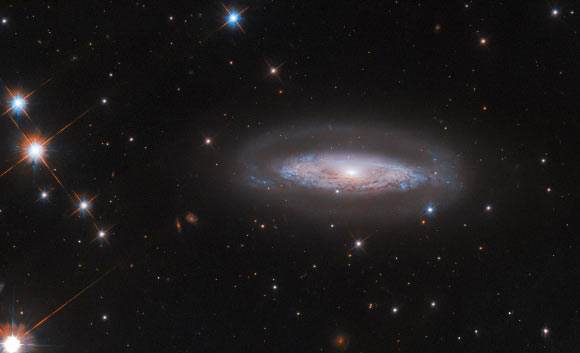Hubble Spots Active Spiral Galaxy in Telescopium

NASA Space Technology
Astronomers using the NASA/ESA Hubble Space Telescope have captured an amazing photo of the lens-shaped spiral galaxy IC 4709.

IC 4709’s swirling disk filled with stars and dust bands is beautifully captured by Hubble, as is the faint halo surrounding it. The color image is made up of observations from Hubble’s Advanced Camera for Surveys (ACS) in the near-infrared and optical parts of the spectrum. It is based on data obtained through two filters. The color results from assigning different hues to each monochromatic image associated with an individual filter. Image credit: NASA / ESA / Hubble / M. Koss / A. Barth.
IC 4709 is located approximately 240 million light-years away in the southern constellation of Telescopium.
Otherwise known as ESO 182-14 or LEDA 61835, this galaxy has a diameter of 60,000 light-years.
IC 4709 was discovered by the American astronomer DeLisle Stewart on September 14, 1901.
The galaxy hosts an active galactic nucleus, a compact region at its center within which material is dragged towards a supermassive black hole.
“If IC 4709’s core were just filled with stars, it would not be nearly so bright,” the Hubble astronomers said in a statement.
“Instead it hosts a gargantuan black hole, 65 million times the mass of our Sun.”
“A disk of gas spirals around and eventually into this black hole, with the gas crashing together and heating up as it spins.”
“It reaches such high temperatures that it emits vast quantities of electromagnetic radiation, from infrared to visible to ultraviolet light and beyond — in this case including X-rays.”
“IC 4709’s active galactic nucleus is obscured by a lane of dark dust, just visible at the center of the galaxy in the Hubble image, which blocks any optical emission from the nucleus itself,” they added.
“Hubble’s spectacular resolution, however, gives us a detailed view of the interaction between the quite small active galactic nucleus and its host galaxy.”
“This is essential to understanding supermassive black holes in galaxies much more distant than IC 4709, where resolving such fine details is not possible.”
Discover more from Tamfis Nigeria Lmited
Subscribe to get the latest posts sent to your email.



 Hot Deals
Hot Deals Shopfinish
Shopfinish Shop
Shop Appliances
Appliances Babies & Kids
Babies & Kids Best Selling
Best Selling Books
Books Consumer Electronics
Consumer Electronics Furniture
Furniture Home & Kitchen
Home & Kitchen Jewelry
Jewelry Luxury & Beauty
Luxury & Beauty Shoes
Shoes Training & Certifications
Training & Certifications Wears & Clothings
Wears & Clothings
















